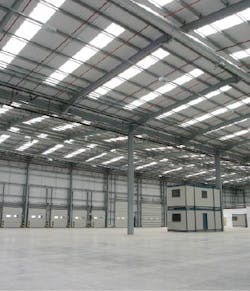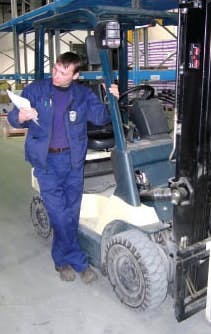The Qualities of Great Distribution Centers
Distribution centers (DCs) operate as the mostly invisible backbone of the supply chain. While many DCs suffer from crowding, disorganization, and inefficiency, some of these facilities stand out as well-oiled machines.
What qualities separate the best from the rest? Read on to discover how three aspects of DCs (location, design, and efficiency) can put your building on the short list of facilities to emulate.
Where Are You?
Considering location for any facility is multifaceted - but it's especially complex for warehouses and DCs. "A distribution center has to be very near a hub or major mode of transportation," says Chuck Sullivan, managing director of North American capital management at Denver-based ProLogis, the world's largest owner, manager, and developer of distribution facilities. "The majority of non-bulk product inside the United States moves via truck, then rail, then air," Sullivan continues, "so you would certainly want to be located near major cities [and] major sources of population. And, for inbound/outbound [facilities], you would need to be near ports with intermodal capabilities."
As fuel prices unfailingly inch upward, the desire for a DC close to where its stock comes/goes also increases. "Locational decision-making, going forward, is going to be much more significant than it was before," says Sullivan, who believes that we have yet to see the highest fuel prices work their way through the system.
Location is also important in attracting good employees. Bryce Benge, development coordination manager and LEED AP at Birtcher Northwest in Lake Oswego, OR, notes the importance of having a facility located in an environmentally suitable location. "Is it easy to walk to food?" he asks. "Is it easy for employees to live nearby and walk to the site? Is it easy for employees to take public transportation to the site? You also have to think about what kinds of environmental hazards are nearby, whether it's endangered-species habitats, wetlands, etc." Benge says that keeping these things in mind has double the benefits. "Actually think about where your building is placed," he says, "so that it's in the most sustainable spot for both the environment and the employees."
Who wouldn't want to work for a company with well-located, sustainable, ergonomically designed, and highly efficient DCs? "All these things make a big difference in employee retention and longevity," says Sullivan. "Attracting good employees and good colleagues to a facility is becoming much more important, so it's got to be a place where folks want to come to work. Traditionally, warehouses haven't fulfilled all of those needs at once."
Having adequate "apron" space for storage containers and space for maneuvering and storage of work vehicles both depend on location, and have also traditionally been ignored. The site plan is just as important as the building itself. It must incorporate room to accommodate moving trucks (a minimum of 125 feet, according to Brandy Birtcher, president and CEO at Irvine, CA-based Birtcher Development and Investments) and sufficient outdoor storage.
Also consider room for expansion. How close are your neighbors? Is there adequate room for building or adding on if your facility becomes overcrowded? Forward-thinking facility professionals will make sure there is plenty of room for outdoor truck and trailer storage, and container storage, and an ample amount of undeveloped or green space for potential expansion. "It's very tempting for builders to overdevelop a site," says Birtcher.
Green Design is a Must
As several industry professionals pointed out, design should always be green. "At the top of everybody's list of what's cutting edge these days is green and sustainable buildings," says Sullivan—and he should know. ProLogis has mandated that all of its new U.S. developments be submitted for LEED certification, a directive that will no doubt force other developers to consider a similar move. But, what aspects of a DC's design should be green?
"When talking about green design elements," says Sullivan, "lighting is the most straightforward one to consider." Birtcher agrees, adding that skylights can help to concentrate more natural light in a distribution facility while lowering energy costs. "You'd be surprised at how skylights can really reduce the cost of warehouse operations," he says. "Most warehouses are very under lit, and there is always a need for higher lighting efficiency, especially over aisles."
He goes on to explain the benefits of having lots of natural light. "You gain two things from skylights," he says. "One is that you have more light in the areas where you need it, and you minimize the amount of artificial light that's necessary in those areas where there's a lot of activity going on. As you get back deeper into the building, you don't need as much light."
Birtcher qualifies that skylights need to be intelligently placed. "Each building has its own set of circumstances," he says. "Most developers or building owners don't pre-design or pre-think the probable locations of aisles and, therefore, make it difficult to put skylights in the appropriate places. It doesn't do much good to put a skylight over the top of four stacks of pallets," he remarks.
New facilities have energy-efficient T5 or T8 fluorescent systems, which, according to Sullivan, have replaced older sodium-vapor or metal-halide fixtures that are currently in most existing buildings in North America. When building new, then, it's clear that natural daylighting (through clerestory windows or skylights) coupled with energy-efficient lighting is the best choice.
According to the Washington, D.C.-based U.S. Energy Information Administration, the median age of a warehouse or distribution facility is approximately 24 years. If your facility falls into this bracket, you are probably looking up at old fluorescent lamps and wondering how much money you're potentially losing. While relamping your buildings may seem like a monumental task, consider this: If your DC is operating 24/7, your lights are working overtime. Retrofitting to T5 or T8 lamps may actually turn out to be a dramatically economical move. Sullivan goes so far as to call this a "simple retrofit" that will result in a more efficient design with a reasonably quick payback.
Older facilities will probably encounter another design problem that younger, more efficient DCs don't face: ceiling heights that are too low. "Even in the ‘70s," says Birtcher, "we didn't have the 30-foot clear heights as regularly as we do now. So, if you're in a building that doesn't have at least 30-foot clear and doesn't have ESFR (early suppression fast response) sprinkler systems in the ceiling, you're probably paying more for your insurance than you should," and you likely don't have as much room to stack pallets, either. "Those are the kinds of things that will render your real estate less useful," Birtcher adds, also noting that ceiling heights should be at least 30 to 40 feet.
Another important design element is virtually married to green: flexibility. If your DC is designed with the flexibility to change up the utilities or the floor arrangements at will, you can more easily convert to sustainable technologies and practices. For instance, a DC built taller than necessary can utilize overhead space as a storage rack over the picking slots. When the facility manager acquires the automation necessary to employ higher pallet stacking, that space will be converted to meet the new use. "The kind of pallets and the kind of stacking machinery is getting more sophisticated all the time," says Birtcher. The same principle applies for leaving open space next to your DC. "We make an effort to design versatile buildings," says Sullivan, "like a building that can be subdivided or expanded, with lots of open space."
Lastly, the building's physical orientation is key. An optimized DC should be positioned so that the region's climate doesn't adversely affect its operations or energy efficiency. Building siting is clearly important. "If you're in southern California or Phoenix, where the sun is streaming in, you would want those doors oriented north so that you don't have the hot sun bearing down on employees in the work area," says Jim Edwards, senior vice president at Birtcher Development and Investments. "And, then, up in the Columbia River Gorge, for example, where we frequently have cold east winds in the winter, you make sure that the doors don't face east so everyone's not working in subzero weather. You want the back side of your facility to always face the foulest weather."
Don't, however, lose sight of one of the most volatile variables of efficiency: worker productivity. While harder to gauge than energy usage, worker productivity is at the heart of your facility's efficiency. Natural lighting has been proven to help, but great DCs also incorporate ergonomic work or picking stations (where workers stand or sit over a conveyor belt to handle products) that allow employees to comfortably reach everything they need without walking away or bending over. "If you've got a more ergonomically friendly building to work in, theoretically, you're going to achieve higher productivity out of your employee base," states Sullivan.
Having a picking space that's designed for ultimate efficiency is also important. New aisle designs are constantly being developed; a team of researchers from the Fayetteville, AR-based University of Arkansas and Auburn University, Auburn, AL, have recently discovered aisle configurations for racks that overwhelmingly surpass conventional designs. Their blog (www.whaisles.blogspot.com) features a discussion on the V-shaped design they came up with. When was the last time you considered updating the configuration of your aisles?
With inefficient aisle configuration, you face overcrowding and confusion, which can lead to mistakes in the processing of products. Automation can reduce some of these problems, but, as Edwards points out, "It will probably be another 30, 40, or 50 years before we get to the point where it's virtually all automated."
A less obvious, but incredibly important, factor in facility efficiency is the way in which a facility manager operates and maintains his or her facility. "Building owners can contribute to the inefficiency of their buildings just by letting them go," says Birtcher, but a proactive owner can improve efficiency through constant maintenance, education on trends and technology, and an interest in sustainable practices.
Having an operator who is flexible can help in another arena that's currently affecting DC efficiency: security. Shipping criteria mandated by the SAFE Port Act of 2006 (including the "Ten Plus Two" requirement) will help maintain the safety of U.S. ports, but it can also be a headache for DC owners and managers. "Now, there are 10 things that have to be done to a container for security purposes offshore, and there are two things they have to do onshore as well, so the more efficient people become in bonding and securitizing with cameras, guards, employee checks, documentation of workers, etc., the better - these things are all critical in maintaining both security and efficiency," says Birtcher.
Ultimately, do some research and decide if your DC is at its peak potential. Don't settle for traditional design and operation with your DC or warehouse facility. And, check out the sidebar (Small Steps Toward Your Best DC) for small steps you can take to make your facility stand out.
Jenna M. Aker ([email protected]) is new products editor at Buildings magazine.


